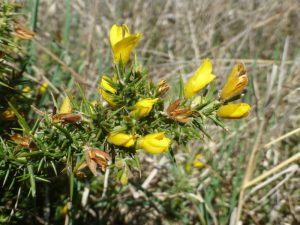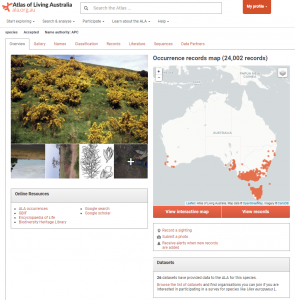
Gorse is one of Australia’s worst weeds, infesting pastoral lands, clogging waterways and damaging natural environments. The Victorian Gorse Taskforce (VGT) leads the effort to reduce Gorse across private and public land in Victoria. They facilitate community-led activities to reduce Gorse in local areas and provide financial and practical support to landowners managing Gorse.
In February, the Victorian Gorse Taskforce invited the ALA to run a series of workshops to explain how the ALA can be used to manage weed and pest problems such as Gorse, and encourage landowners and community members to upload sightings into the ALA.
“Gorse is highly invasive and persistent,” said Chair of the VGT Peter Everist. “The longer you leave it, the longer it takes to control. Gorse plants produce large amounts of seed each year and they can last in the soil for decades, meaning one year of seeding generates decades of weeding”.
Dr Everist said that Gorse has a number of detrimental impacts including reduced agricultural capacity, threatening biodiversity and providing harbour for invasive animals. “If that doesn’t concern you then the fact that it dramatically reduces your land value and creates a significant fire risk to your property might,” he said.
Peter Brenton, ALA’s Manager, Data Collection & Community Engagement, delivered six workshops to 135 people in five locations across Victoria: Daylesford, Ballan, Beechworth, Drysdale, and Bass. Another workshop is scheduled to be held in Portland in April this year.
The workshops explained the key features of the ALA including how to upload sightings, how to set up simple projects and surveys using BioCollect – the ALA’s field data collection platform, and how to view data.
Peter also presented sessions on navigating the ALA, data quality, and explained the DigiVol crowd-sourced digitisation platform.
“The Atlas of living Australia will give groups the opportunity to easily map, not only the distribution of Gorse and other invasive species, but also the native biodiversity that shares the same ecosystem” said VGT Chair, Peter Everist. The Atlas of Living Australia provides a platform to document the occurrence of Gorse in Victoria and a project management tool for running weed control programs through the Atlas’s Natural Resource Management form in BioCollect.”
Comments from participants:
“A great way to get the community interested in participating in citizen science projects.” Participant from Ballan.
“I will be considering BioCollect as an alternative to other form-based collection tools.” Participant from Ballan.
“I was surprised by the number of things the ALA can do and its uses.” Participant from Beechworth
“Using ALA I will be able to use existing local species data to monitor local biodiversity health, and also monitor species to evaluate changes in local ecological decline or recovery.” Participant from Beechworth.
“It will be useful to add our existing data e.g. nest box monitoring, species distribution, weed survey data, to the ALA. And it will be useful to use BioCollect to record new data.” Participant from Beechworth.
“As a land manager, being able to collect and display data in order to direct decision making is great. This will also help us to support our volunteers.” Participant from Drysdale.
